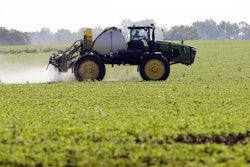WALTONVILLE, Ill. (AP) — With a baking southern Illinois cornfield as a backdrop, Gov. Pat Quinn on Monday pledged state support through loans and debt restructuring to farmers and ranchers punished by a nagging drought that shows no signs of abating anytime soon.
The Democrat's first look at parched conditions that has most of the state classified as in a drought gave him a stark lesson in just how bad things have gotten on the James Laird family's farm near Waltonville, a 400-resident village about 80 miles southeast of St. Louis. Stepping briefly into the crop, its dry soil craving any moisture, Quinn struggled to find an ear of corn. When he found one, he shucked it, only to discover it had no kernels.
Quinn moments earlier had cast the plight of the state's corn growers in almost tragic terms. "This is their hour of need, and we will not forget them," he said.
"We've never seen a drought like this and we've got to do something about it," Quinn, sweating in temperatures reaching well into the 90s, said during a news conference skirting the cornfield in an area he fretted has gotten just six-tenths of an inch of rain in the past month.
Quinn's sojourn into a parched rural stretch of Illinois came as two-thirds of the state is classified as being in severe drought or worse, according to climatologist Mark Svoboda with the Nebraska-based National Drought Mitigation Center's Drought Monitor. Eight percent of the Land of Lincoln, largely the state's southernmost tip, is in "extreme drought."
Just three months ago, Svoboda said, only 5 percent of the state was in any form of drought. Climatologists are calling it as "a flash drought," meaning it develops in a matter of months and not over multiple seasons or years.
"This is definitely the epicenter, right in the heart of the Midwest," including eastern Missouri, Svoboda said.
Using the Drought Monitor tracking as a guide, the U.S. Department of Agriculture last week announced that more than 1,000 counties in some two dozen states — including 26, mostly southern counties in Illinois — automatically will qualify for streamlined disaster assistance if they're in a severe drought for at least eight weeks or were in extreme drought this growing season.
Quinn said seven more Illinois counties — Bond, Champaign, Greene, Monroe, Morgan, Stephenson and Washington — were added to that list Monday, punctuating the spread of the drought's impact through a state usually among the nation's top corn and soybean producers.
While thankful for the USDA's offer of relief, Quinn insisted the state also was willing to come to the rescue through various debt-restructuring and loan programs through a partnership between the Illinois Finance Authority and area banks.
The state also launched a website, Drought.Illinois.gov, as a repository for all things involving the state's drought situation, including available aid for affected growers and ranchers.
"We're the heart of the heartland," Quinn said, renewing his request from last week that residents pray for rain.
The Illinois Farm Bureau has said this year is the sixth-driest year on record so far, with the average precipitation of 2012's first half just 12.6 inches, nearly seven inches below normal. Every month this year has had above-normal temperatures, and the statewide average of 52.8 degrees over the past sixth months is the warmest on record.
"This is truly a learning experience for all of us," said Bob Flider, the Illinois Department of Agriculture's acting director.






















